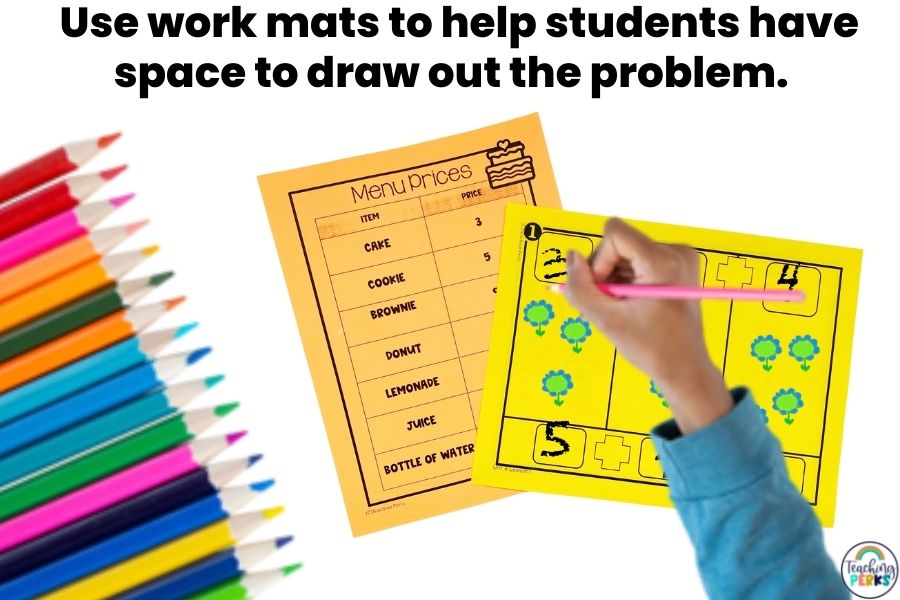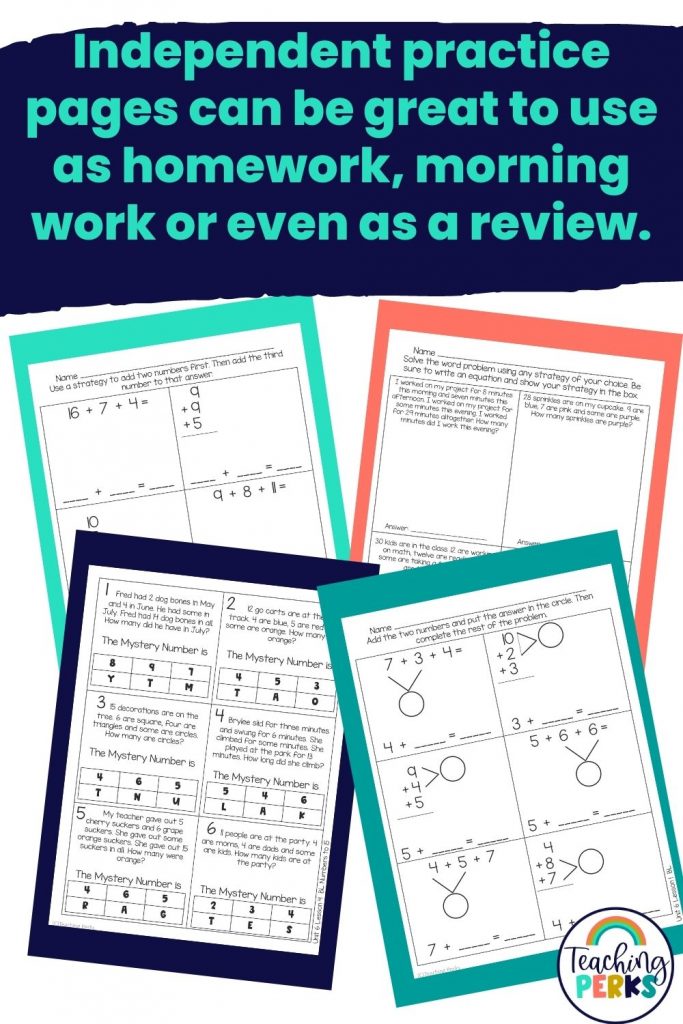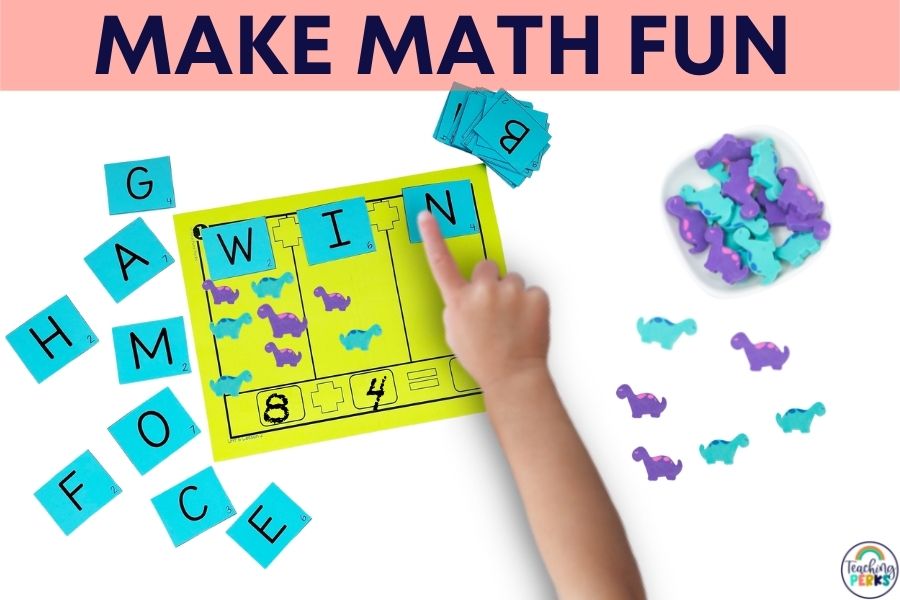After tackling basic counting and addition, your 1st grade students will need to learn an adding strategy for how to add three numbers together. According to Core Standard 1.OA.A.2., they will need to solve word problems that use three numbers adding up to a sum equal to or less than 20. Rather than trying to figure out lessons on your own, let’s talk about the different addition strategies that I use in my classroom!


Practicing With Objects
For some students, adding a manipulative aspect to their learning can help them understand the concept… especially when it comes to story problems! These can be difficult for students to break down and understand what they actually need to know. When you add in objects like counters, cubes, or base ten blocks, they can easily break down the parts of the problem using objects! Mental strategies do not work for everyone, especially in the younger grades.

Just like with regular addition, teaching addition using three numbers can be done with manipulation. You can teach this addition strategy by filling three buckets with different-colored connecting cubes, marbles, crayons, etc. Then, students can reach into each bucket and pull out a small handful of items to create an addition problem and even write addition equations. This strategy works best with single-digit numbers. These hands-on strategies will make all the difference in your classroom!

Another way you can use objects to practice adding three numbers is by giving each student a different amount of cubes or counters. Then, have them go around the room and find 2 other people to create an addition problem with. They can write down how many cubes they have as well as how many cubes the other two students have, then work together to solve the problem! Students will all different levels of math can participate in this activity together.
Use Work Mats to Visualize
My favorite adding strategy is to use work mats! These are great for guided practice and in math groups! Additionally, while using objects is typically a good start for below-level students, work mats are great to use with all levels. I like to use work mats so my students can write out the parts of the word problems. There is also space for them to draw pictures to help them visualize if they need to! You can practice this in the same way you practice with objects. Work through story problems together and have students fill in the solution!

Give Students Time For Independent Practice
The first two examples are great for whole group or small group instruction… But there will definitely be times when you want students to practice these skills independently and use the excellent tools they have learned in your lessons! To help secure a newly taught adding strategy, first graders should be given ample time to practice. Also, above-level students may need the extra challenge of testing this concept on their own by using mental math strategies. You can use independent practice pages for homework, morning work, or practice while you work with small groups.

Playing an addition skills game with dice is a great independent activity to challenge students. Give students 3 dice and have them roll each to see which numbers they will be working with. Then, have them write down the numbers on a sheet of paper or whiteboard, create number sentences and solve the problem!
Make it Fun By Playing Games
The best adding strategy is to make math enjoyable! That’s why I include games with each of my lessons. This allows students to use their knowledge of addition to play the game successfully. Playing games allow students to think outside of the box or look at the concept in a different way to reach their full potential in math. The more ways you can incorporate this new addition concept, the easier it will be for them to grasp an important skill!

One of my favorite games for adding three numbers is Spin and Cover. You get this game as part of my Adding 3 Numbers Lesson Plans bundle! To play the game, your students will spin 3 spinners and then add up all of the numbers. Then, they cover up the sum on their worksheet!

Additionally, students love anything that gets them up and moving! A fun way to incorporate movement with this standard is by having the students be the parts of the addition problem. For example, you could have your students move to three separate parts of the room based on different categories, such as those wearing white shoes, black shoes, or any other color of shoes. You could also do this based on pets, birthday months, favorite foods, etc. Once the students move into their group, they can work together to count up how many students are in each group across the room. Then, have them come back together and share the problems they came up with!
Planning for Differentiation
As with all new concepts, you should plan for differentiation for your below-level, on-level, and above-level students. Make sure to include extra practices (such as using manipulatives as mentioned above) for below-level students. On the other hand, your above-level students may need additional challenges to keep them engaged.
This is why I include so many different activities in my Adding 3 Numbers Small Group Math Lessons. These lesson plans include 5 daily lesson plans with games, independent practice pages, questions to ask, answer keys, challenges, and differentiation ideas for all of your students!
You can try out a full sample lesson from unit 1 to get an idea of how each unit and lesson is planned out!

Adding Strategy That Make Adding Three Numbers Fun
For some students, math can be a real struggle. That’s why practicing the concept of adding three numbers in different ways is so important! When students have a range of strategies to solve a problem they become more confident in math. My lesson plan bundles are a great way to teach this concept (and others!) because they meet multiple standards, include differentiation, and require very little prep! If you want a full year of math activities taken care of, go check out my Small Group Math bundle for first grade!
Are you loving these strategies for addition? I have another blog post with 15 Simple and Powerful Small Group Strategies For Addition and Subtraction. Make sure you subscribe to the blog for more teaching tips!
Your writing style is cool and I have learned several just right stuff here. I can see how much effort you’ve poured in to come up with such informative posts. If you need more input about Airport Transfer, feel free to check out my website at UQ4